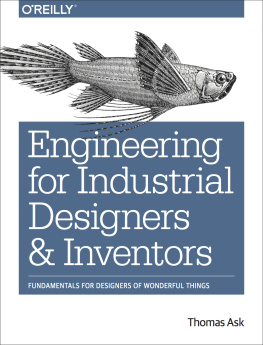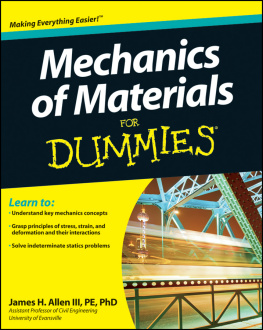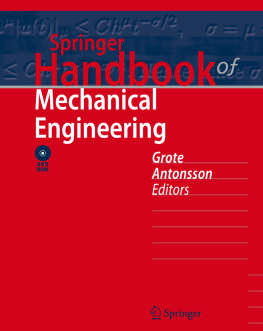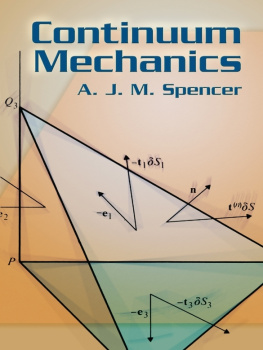Engineering for Industrial Designers and Inventors
by Thomas Ask
Copyright 2016 Thomas Ask. All rights reserved.
Printed in the United States of America.
Published by OReilly Media, Inc. , 1005 Gravenstein Highway North, Sebastopol, CA 95472.
OReilly books may be purchased for educational, business, or sales promotional use. Online editions are also available for most titles (http://safaribooksonline.com). For more information, contact our corporate/institutional sales department: 800-998-9938 or corporate@oreilly.com .
- Editors: Nan Barber and Susan Conant
- Acquisitions Editor: Laurel Ruma
- Production Editor: Shiny Kalapurakkel
- Copyeditor: Kim Cofer
- Proofreader: Jasmine Kwityn
- Indexer: Angela Howard
- Interior Designer: David Futato
- Cover Designer: Karen Montgomery
- Illustrator: Rebecca Demarest
- April 2016: First Edition
Revision History for the First Edition
- 2016-04-27: First Release
See http://oreilly.com/catalog/errata.csp?isbn=9781491932612 for release details.
The OReilly logo is a registered trademark of OReilly Media, Inc. Engineering for Industrial Designers and Inventors, the cover image, and related trade dress are trademarks of OReilly Media, Inc.
While the publisher and the author(s) have used good faith efforts to ensure that the information and instructions contained in this work are accurate, the publisher and the author(s) disclaim all responsibility for errors or omissions, including without limitation responsibility for damages resulting from the use of or reliance on this work. Use of the information and instructions contained in this work is at your own risk. If any code samples or other technology this work contains or describes is subject to open source licenses or the intellectual property rights of others, it is your responsibility to ensure that your use thereof complies with such licenses and/or rights.
978-1-491-93261-2
[LSI]
Preface
We are all impatient. We want everything at our fingertips on demand. What this book does is cut to the core elements of mechanical engineering without interrupting your study with too much noise. The theory is rigorous, the math is not. I prefer qualitative descriptions and analogies over math. The goal of this book is to make mechanical engineering a real tool in your inventive, creative tool belt. I want you to understand basic concepts that can inform the copious decisions required when designing a real object. Reading a book is certainly a test of patience, and I admire your foray into this walk together. Your time is under assault by many things. Your slices of open time are presented with enticing tweets and games so that your time is not linear and logical but rather a polymodal blend of grand endeavors and tiny treats. Where is the time for reflection?
Death by Video
Drunken eyes seducing minds
Flashing fluorescence digging
Synapses fire on and off
on and off
on and off
Eyes blink only for water
Gently cooling heated sight
Washing across digital rough
As the synapses fire on and off
Chant a dirge or scumble color
While watching forced slumber
Noises zipping, busy, fuzzy dots
Blinking, blanching, watching plots
Jam the mind in a keyboard crack
Waiting on your electro-sausage.
Synapses. fire. on. and. off.
on. and. off.
on. and. off.
Thomas Ask (Excelsior Review, Issue No. 5, April 2015)
This book is for creators, content providers, inventors, and those who create mechanical marvels from the void. It is for those who work in all three dimensions and strive to take their wonderful ideas and move them to reality. We all wish to be experts in something. We self-identify our qualities, develop a group affiliation, and protect that in which we take pride. The often unspoken secret is that we can be good in multiple thingswe can learn, adapt, and morph as we fight complacency.
Many of us bounce ideas around in our mind and with friends and family. These ideas bring us great promise, joy, and wonder. However, turning ideas into functional products requires specific technical knowledge. During the creative process of design, this knowledge needs to be visceral and drawn from the fingertips like yellow, crackling lightning bolts. You dont want to have to look up information and analyze something, you just want to design. You want to stand on the shoulders of giants, mixing your delightful creativity with engineering.
Why I Wrote This Book
I wanted to open up the world of mechanical engineering to others. I saw many people with great ideas who couldnt work out the engineering polish on their designs. They would design a feature that was likely to break or distort. They would make some feature that would discourage cooling or cause high drag.
My mechanical engineering education was a theoretical, calculus-based presentation of concepts. Much time was spent in deriving equations and quantitative analyses. When I worked as a designer, I found that this knowledge didnt serve me well. I couldnt analyze something I hadnt designed. Even after concepts are agreed upon, the detailed design of a part requires many decisions that allow it to be lighter, stronger, cooler, or whatever the design goals are. You had to put your best guess up for analysis. The multiple design decisions on an objects physical qualities (thickness, radius, roughness, etc.) are based on having an intuitive feel for how solids, liquids, and gases behave.
Typically, design methodology calls for a sequence of events, which in their simplest form are the clear definition of design requirements, development of concepts, and finally engineering the final design and manufacturing approach. However, many more ambiguous factors get introduced into the design process. Because design is done by humans and typically for human use, a long list of factors are introduced into the development of designs, ranging from the sociological forces of group identity and organizational behavior to an organizations politics, individual egos, and ethics. Aesthetics assert a subliminal force even on the most nonconsumer-oriented design. Moreover, technical and business issues arise to provide design direction, such as ergonomics, performance, longevity, capital costs, and profitability. Regulatory forces such as safety standards often provide some baseline for starting a design while corporate attitudes toward environmental sustainability and manufacturing preferences can suggest design approaches.
Traditionally, design requires technical skills and experience to ensure that the product or system works in the way it is intended. Therefore, product design is often left to the engineers. However, intangible forces become integrated into the design and direct the final appearance of the design. The sometimes subliminal forces can be brought to light through an interdisciplinary study such as occurs in the industrial design discipline. Although industrial design has technical aspects, the discipline carefully considers aesthetic, social, cultural, and organizational forces. This book should ground industrial designers and inventors in mechanical engineering but it should open up other lines of inquirythe nontechnical affairs that make a product fun and relevant. I think all good designs have an element of surprise and playfulness. We all have the capability to engage many disciplines in pursuit of excellence in creating products.
How This Book Is Organized
Designers consider every single aspect of a design and the user experience. Nothing is left outfrom the sound and feel to the particular requirements determined by anthropometry and kinesiology. Machine design is result-oriented rather than human-oriented. However, a machine designer can certainly have a wonderful sense of aesthetics and ergonomics, while an industrial designer can have a powerful ability to understand complex systems and a strong conceptual grasp of engineering principles.













